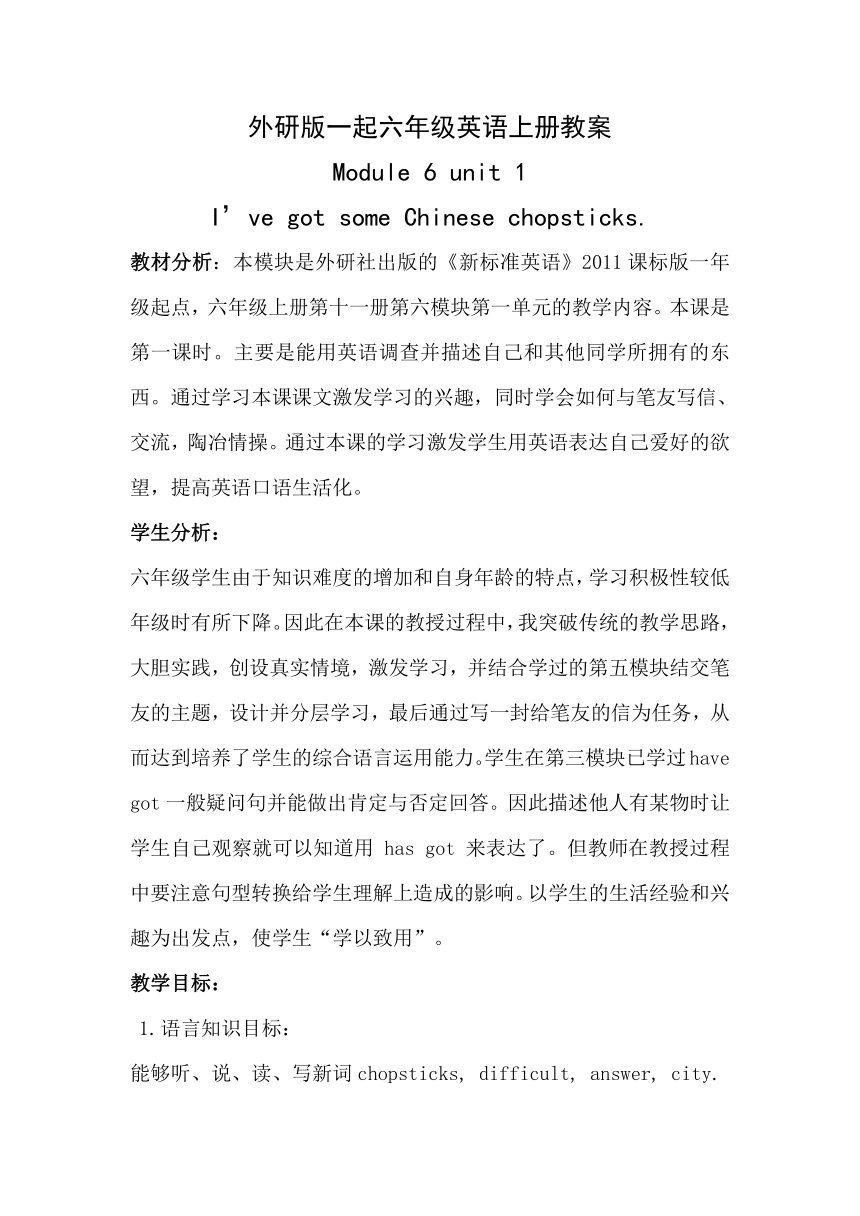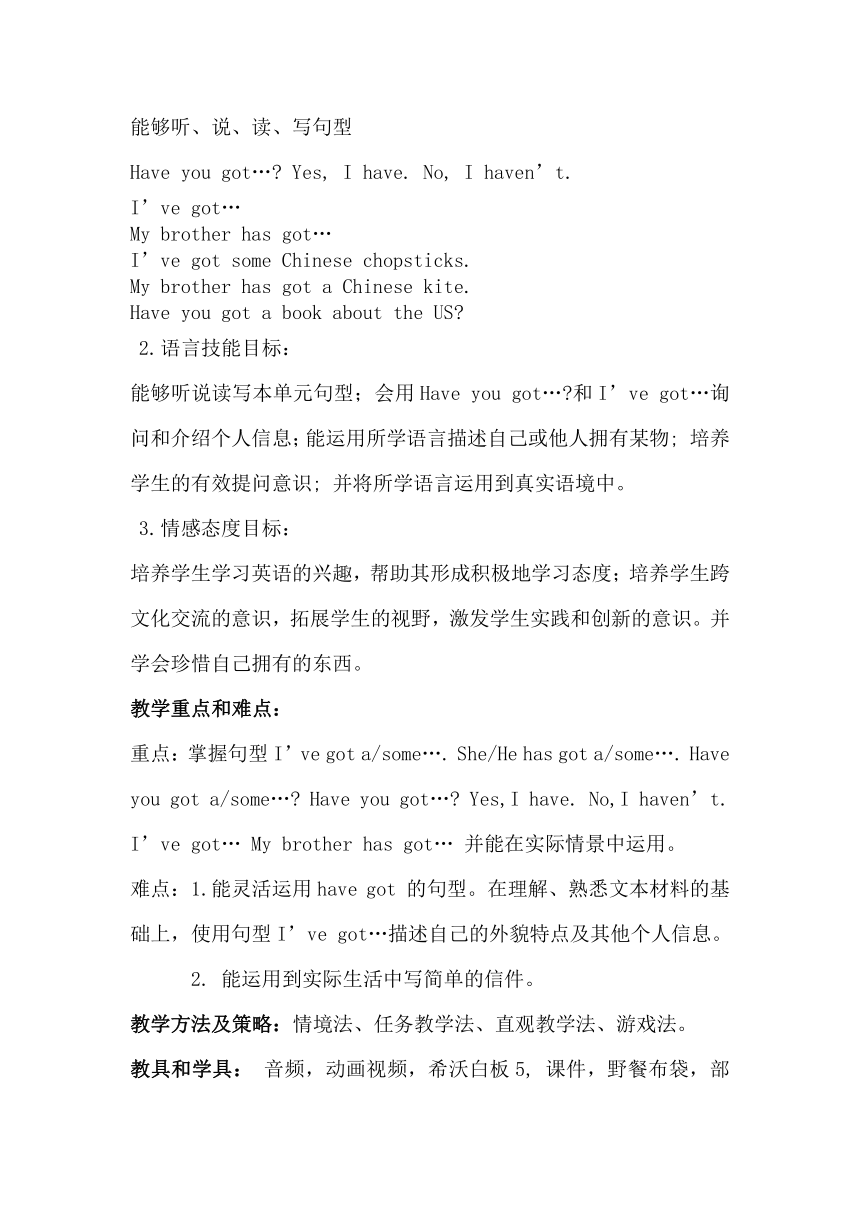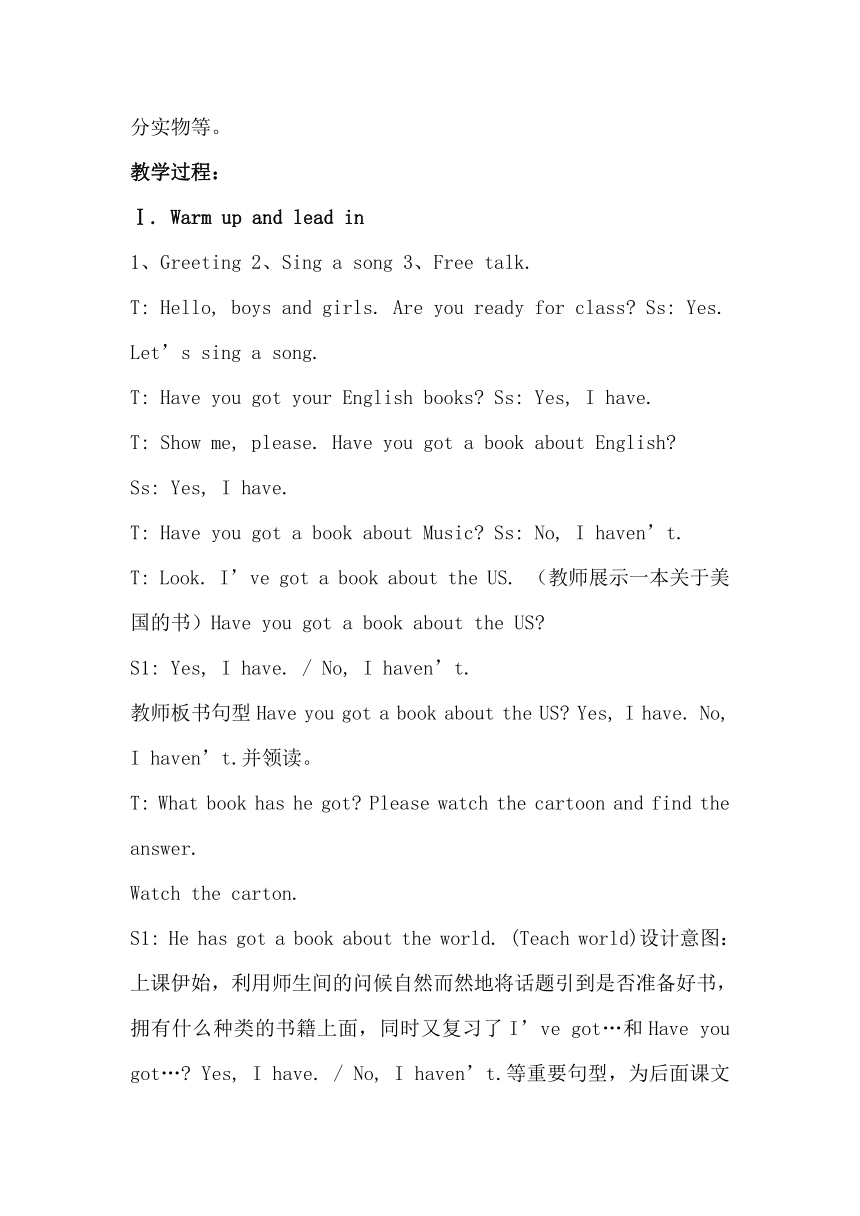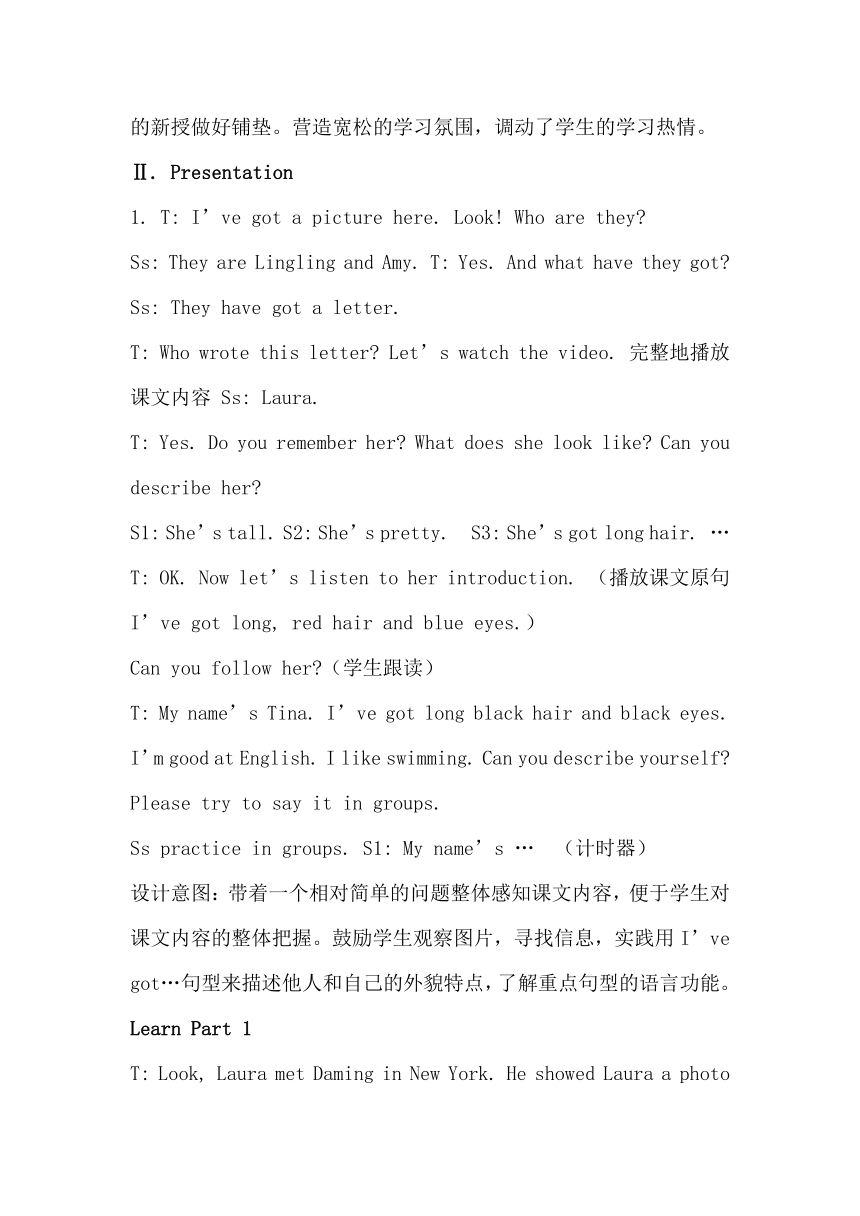Module 6 Unit 1 I've got some Chinese chopsticks. 教案
文档属性
| 名称 | Module 6 Unit 1 I've got some Chinese chopsticks. 教案 |

|
|
| 格式 | doc | ||
| 文件大小 | 46.5KB | ||
| 资源类型 | 教案 | ||
| 版本资源 | 外研版(一年级起点) | ||
| 科目 | 英语 | ||
| 更新时间 | 2022-06-24 20:02:42 | ||
图片预览




文档简介
外研版一起六年级英语上册教案
Module 6 unit 1
I’ve got some Chinese chopsticks.
教材分析:本模块是外研社出版的《新标准英语》2011课标版一年级起点,六年级上册第十一册第六模块第一单元的教学内容。本课是第一课时。主要是能用英语调查并描述自己和其他同学所拥有的东西。通过学习本课课文激发学习的兴趣,同时学会如何与笔友写信、交流,陶冶情操。通过本课的学习激发学生用英语表达自己爱好的欲望,提高英语口语生活化。
学生分析:
六年级学生由于知识难度的增加和自身年龄的特点,学习积极性较低年级时有所下降。因此在本课的教授过程中,我突破传统的教学思路,大胆实践,创设真实情境,激发学习,并结合学过的第五模块结交笔友的主题,设计并分层学习,最后通过写一封给笔友的信为任务,从而达到培养了学生的综合语言运用能力。学生在第三模块已学过have got一般疑问句并能做出肯定与否定回答。因此描述他人有某物时让学生自己观察就可以知道用 has got 来表达了。但教师在教授过程中要注意句型转换给学生理解上造成的影响。以学生的生活经验和兴趣为出发点,使学生“学以致用”。
教学目标:
1. 语言知识目标:
能够听、说、读、写新词chopsticks, difficult, answer, city.
能够听、说、读、写句型
Have you got… Yes, I have. No, I haven’t.
I’ve got…
My brother has got…
I’ve got some Chinese chopsticks.
My brother has got a Chinese kite.
Have you got a book about the US
2. 语言技能目标:
能够听说读写本单元句型;会用Have you got… 和I’ve got…询问和介绍个人信息;能运用所学语言描述自己或他人拥有某物; 培养学生的有效提问意识; 并将所学语言运用到真实语境中。
3. 情感态度目标:
培养学生学习英语的兴趣,帮助其形成积极地学习态度;培养学生跨文化交流的意识,拓展学生的视野,激发学生实践和创新的意识。并学会珍惜自己拥有的东西。
教学重点和难点:
重点:掌握句型I’ve got a/some…. She/He has got a/some…. Have you got a/some… Have you got… Yes,I have. No,I haven’t. I’ve got… My brother has got… 并能在实际情景中运用。
难点:1.能灵活运用have got 的句型。在理解、熟悉文本材料的基础上,使用句型I’ve got…描述自己的外貌特点及其他个人信息。
2. 能运用到实际生活中写简单的信件。
教学方法及策略:情境法、任务教学法、直观教学法、游戏法。
教具和学具: 音频,动画视频,希沃白板5, 课件,野餐布袋,部分实物等。
教学过程:
Ⅰ. Warm up and lead in
1、Greeting 2、Sing a song 3、Free talk.
T: Hello, boys and girls. Are you ready for class Ss: Yes.
Let’s sing a song.
T: Have you got your English books Ss: Yes, I have.
T: Show me, please. Have you got a book about English
Ss: Yes, I have.
T: Have you got a book about Music Ss: No, I haven’t.
T: Look. I’ve got a book about the US. (教师展示一本关于美国的书)Have you got a book about the US
S1: Yes, I have. / No, I haven’t.
教师板书句型Have you got a book about the US Yes, I have. No, I haven’t.并领读。
T: What book has he got Please watch the cartoon and find the answer.
Watch the carton.
S1: He has got a book about the world. (Teach world)设计意图:上课伊始,利用师生间的问候自然而然地将话题引到是否准备好书,拥有什么种类的书籍上面,同时又复习了I’ve got…和Have you got… Yes, I have. / No, I haven’t.等重要句型,为后面课文的新授做好铺垫。营造宽松的学习氛围,调动了学生的学习热情。
Ⅱ. Presentation
1. T: I’ve got a picture here. Look! Who are they
Ss: They are Lingling and Amy. T: Yes. And what have they got Ss: They have got a letter.
T: Who wrote this letter Let’s watch the video. 完整地播放课文内容 Ss: Laura.
T: Yes. Do you remember her What does she look like Can you describe her
S1: She’s tall. S2: She’s pretty. S3: She’s got long hair. …
T: OK. Now let’s listen to her introduction. (播放课文原句I’ve got long, red hair and blue eyes.)
Can you follow her (学生跟读)
T: My name’s Tina. I’ve got long black hair and black eyes. I’m good at English. I like swimming. Can you describe yourself Please try to say it in groups.
Ss practice in groups. S1: My name’s … (计时器)
设计意图:带着一个相对简单的问题整体感知课文内容,便于学生对课文内容的整体把握。鼓励学生观察图片,寻找信息,实践用I’ve got…句型来描述他人和自己的外貌特点,了解重点句型的语言功能。
Learn Part 1
T: Look, Laura met Daming in New York. He showed Laura a photo of Lingling. Laura wants a Chinese pen friend. So she wrote this letter. What does Laura want to know Ss: Can you be my pen friend
Learn Part 2 (1) T: Here’s a task for you. Please read the second paragraph and answer the three questions. You can underline the key words on your books.
T: What food does Laura like S1: She likes Chinese food.
T: What has she got S2: She has got some Chinese chopsticks. T to S2: How do you know that S2:(找出课文中的原句I’ve got some Chinese chopsticks.) 教师板书该句,并领读。
T: Have you got Chinese chopsticks Can you use chopsticks Is it difficult for you to use them Yes, it’s easy for us to use them.(与学生随时交流,既复习了旧知识,又为学习后面的课文内容做好了准备。)
T: What has her brother got S3: Her brother has got a Chinese kite. T to S3: How do you know that S3:(找出课文中的原句My brother has got a Chinese kite.)
教师板书该句,并领读。T: Have you got a kite What does it look like Can you fly a kite Where do you usually fly your kite 设计意图:对于小学高段学生来说带着问题阅读文本材料是一种有效地阅读方法,教师需要加以指导,例如在提醒学生在阅读的过程中找出解答问题的关键词、句,这对提高学生的阅读能力十分有帮助。就某话题与学生随时的交流,可以锻炼其灵活使用语言的技巧,同时丰富了学生的语言知识,增强了语感,也凸显了英语的工具性特征。
(2) T: Look. What has he got Ss: He has got a football. T: Who can ask Who can answer S1: What has she got S2: She has got a bag. T: What have they got Ss: They have got a book. Ss ask and answer in pairs. What have they got They have got a Chinese kite. T: Look at the kite. It is a very big bird.
设计意图:借助直观的图片,激发学生的主动性,引领学生关注动词have got/has got的变化,及时操练巩固。
Learn Part 3
T: Now let’s go on reading this letter.
Which city does Laura come from Please read the third paragraph and find the answer.
S1: She’s from New York.
T: Do you know New York Please look at the screen.
Ss watch the video. T: Tell me something about New York, please. S1: It’s a big city. S2: It’s a beautiful city. …
T: Where is New York Can you find it
Ss: Yes. It’s in the east of the US.
T: What’s this Do you know It’s the Statue of Liberty. It’s a famous landmark of the US. It’s in New York.
T: Look at this place. There are lots of Chinese shops and restaurants. Do you know this place Ss: Chinatown.
T: Right. There’s a big Chinatown in New York.
And this is the UN building. It’s in New York.
设计意图:语言的学习有助于学生认识世界的多样性,结合本课出现的New York通过看视频、谈论相关文化知识,引领学生感受中外文化的异同,形成跨文化意识。
T: At the end of the letter Laura asked a question. What is it Ss: Have you got a book about the US
T: Then Laura wrote “Please write back.” What’s its meaning Ss: Please reply. Write to me soon.
Read the sentence “Please write back.”
设计意图:引导学生在阅读中获取信息,复现已学知识,以旧引新,体现了学生的主体地位。
T: Children, what does Laura talk about in this letter Please discuss in groups and choose.
设计意图:学生借助教师搭构的语言支架,由词到句,小组合作总结课文中这封信的主要内容,引导学生学会梳理信息,体现了全员参与、合作学习、自主学习的理念。
Listen and repeat. Try to imitate.Role play.
Pay attention to your pronunciation and intonation. Then practice in different roles in groups. Choose 1 group to show. 设计意图:整体听音跟读,模仿动画中地道的语音语调,分角色小组练习对话,让学生在情景中再次理解短文。
Ⅲ. Practice and consolidation.
1. Play a guessing game.
T: I usually have a picnic at the weekend. This weekend I’m going to have a picnic. I’ve put something in my bag. Please guess what I’ve got in my bag. S1: Have you got… T: Yes, I have. / No, I haven’t. …
设计意图:借助图片和实物创设情境,通过师生交流,在猜一猜的游戏中操练重点句型,调动每个学生的积极性。
2. Talk about your room.
T: Sometimes I stay at home at the weekend. Look, this is my room. I’ve got some books, a chair and a bed. What have you got in your room Please discuss in groups.
设计意图:根据学生的年龄特点,创设真实的情境,让学生联系实际在轻松愉快的气氛中练习运用所学重点语句。
3. Write a letter to Laura.
T: Do you want to be pen friend with Laura Ss: Yes.
T: Maybe you can get more information about the US from Laura. And you can ask Laura a question about the US at the end of the letter. Let’s write letters to Laura. The students write letters.Then read their letters.
设计意图:给Laura写信,是一个结合听、说、读、写的练习,对学生提出了更高的要求。此外,培养学生的提问意识非常重要。结合Laura信里的最后一句话Please write back and I will answer your questions about the US. 要求学生要在信中提问题,锻炼了学生的提问能力。
Ⅳ. Summary
At first the students sum up the key points they have learnt today.
T: Yes, today we’ve reviewed the sentence patterns “Have you got… I’ve got … He’s got… She’s got… What have you got ” If we change “I” “You” to “He” or “She”. What shall we say S1: Has she got a book about the US Yes, she has. No, she hasn’t. She’s got some Chinese chopsticks. 设计意图:发挥学生的主动性,引导学生自己总结和归纳本课学习的重点句型和动词变化,强调重点句型的语用功能。
Ⅴ. Blackboard design
Module 6 unit 1
I’ve got some Chinese chopsticks.
Have you got… Yes, I have. No, I haven’t.
I’ve got…
My brother has got…
I’ve got some Chinese chopsticks.
My brother has got a Chinese kite.
Have you got a book about the US
Module 6 unit 1
I’ve got some Chinese chopsticks.
教材分析:本模块是外研社出版的《新标准英语》2011课标版一年级起点,六年级上册第十一册第六模块第一单元的教学内容。本课是第一课时。主要是能用英语调查并描述自己和其他同学所拥有的东西。通过学习本课课文激发学习的兴趣,同时学会如何与笔友写信、交流,陶冶情操。通过本课的学习激发学生用英语表达自己爱好的欲望,提高英语口语生活化。
学生分析:
六年级学生由于知识难度的增加和自身年龄的特点,学习积极性较低年级时有所下降。因此在本课的教授过程中,我突破传统的教学思路,大胆实践,创设真实情境,激发学习,并结合学过的第五模块结交笔友的主题,设计并分层学习,最后通过写一封给笔友的信为任务,从而达到培养了学生的综合语言运用能力。学生在第三模块已学过have got一般疑问句并能做出肯定与否定回答。因此描述他人有某物时让学生自己观察就可以知道用 has got 来表达了。但教师在教授过程中要注意句型转换给学生理解上造成的影响。以学生的生活经验和兴趣为出发点,使学生“学以致用”。
教学目标:
1. 语言知识目标:
能够听、说、读、写新词chopsticks, difficult, answer, city.
能够听、说、读、写句型
Have you got… Yes, I have. No, I haven’t.
I’ve got…
My brother has got…
I’ve got some Chinese chopsticks.
My brother has got a Chinese kite.
Have you got a book about the US
2. 语言技能目标:
能够听说读写本单元句型;会用Have you got… 和I’ve got…询问和介绍个人信息;能运用所学语言描述自己或他人拥有某物; 培养学生的有效提问意识; 并将所学语言运用到真实语境中。
3. 情感态度目标:
培养学生学习英语的兴趣,帮助其形成积极地学习态度;培养学生跨文化交流的意识,拓展学生的视野,激发学生实践和创新的意识。并学会珍惜自己拥有的东西。
教学重点和难点:
重点:掌握句型I’ve got a/some…. She/He has got a/some…. Have you got a/some… Have you got… Yes,I have. No,I haven’t. I’ve got… My brother has got… 并能在实际情景中运用。
难点:1.能灵活运用have got 的句型。在理解、熟悉文本材料的基础上,使用句型I’ve got…描述自己的外貌特点及其他个人信息。
2. 能运用到实际生活中写简单的信件。
教学方法及策略:情境法、任务教学法、直观教学法、游戏法。
教具和学具: 音频,动画视频,希沃白板5, 课件,野餐布袋,部分实物等。
教学过程:
Ⅰ. Warm up and lead in
1、Greeting 2、Sing a song 3、Free talk.
T: Hello, boys and girls. Are you ready for class Ss: Yes.
Let’s sing a song.
T: Have you got your English books Ss: Yes, I have.
T: Show me, please. Have you got a book about English
Ss: Yes, I have.
T: Have you got a book about Music Ss: No, I haven’t.
T: Look. I’ve got a book about the US. (教师展示一本关于美国的书)Have you got a book about the US
S1: Yes, I have. / No, I haven’t.
教师板书句型Have you got a book about the US Yes, I have. No, I haven’t.并领读。
T: What book has he got Please watch the cartoon and find the answer.
Watch the carton.
S1: He has got a book about the world. (Teach world)设计意图:上课伊始,利用师生间的问候自然而然地将话题引到是否准备好书,拥有什么种类的书籍上面,同时又复习了I’ve got…和Have you got… Yes, I have. / No, I haven’t.等重要句型,为后面课文的新授做好铺垫。营造宽松的学习氛围,调动了学生的学习热情。
Ⅱ. Presentation
1. T: I’ve got a picture here. Look! Who are they
Ss: They are Lingling and Amy. T: Yes. And what have they got Ss: They have got a letter.
T: Who wrote this letter Let’s watch the video. 完整地播放课文内容 Ss: Laura.
T: Yes. Do you remember her What does she look like Can you describe her
S1: She’s tall. S2: She’s pretty. S3: She’s got long hair. …
T: OK. Now let’s listen to her introduction. (播放课文原句I’ve got long, red hair and blue eyes.)
Can you follow her (学生跟读)
T: My name’s Tina. I’ve got long black hair and black eyes. I’m good at English. I like swimming. Can you describe yourself Please try to say it in groups.
Ss practice in groups. S1: My name’s … (计时器)
设计意图:带着一个相对简单的问题整体感知课文内容,便于学生对课文内容的整体把握。鼓励学生观察图片,寻找信息,实践用I’ve got…句型来描述他人和自己的外貌特点,了解重点句型的语言功能。
Learn Part 1
T: Look, Laura met Daming in New York. He showed Laura a photo of Lingling. Laura wants a Chinese pen friend. So she wrote this letter. What does Laura want to know Ss: Can you be my pen friend
Learn Part 2 (1) T: Here’s a task for you. Please read the second paragraph and answer the three questions. You can underline the key words on your books.
T: What food does Laura like S1: She likes Chinese food.
T: What has she got S2: She has got some Chinese chopsticks. T to S2: How do you know that S2:(找出课文中的原句I’ve got some Chinese chopsticks.) 教师板书该句,并领读。
T: Have you got Chinese chopsticks Can you use chopsticks Is it difficult for you to use them Yes, it’s easy for us to use them.(与学生随时交流,既复习了旧知识,又为学习后面的课文内容做好了准备。)
T: What has her brother got S3: Her brother has got a Chinese kite. T to S3: How do you know that S3:(找出课文中的原句My brother has got a Chinese kite.)
教师板书该句,并领读。T: Have you got a kite What does it look like Can you fly a kite Where do you usually fly your kite 设计意图:对于小学高段学生来说带着问题阅读文本材料是一种有效地阅读方法,教师需要加以指导,例如在提醒学生在阅读的过程中找出解答问题的关键词、句,这对提高学生的阅读能力十分有帮助。就某话题与学生随时的交流,可以锻炼其灵活使用语言的技巧,同时丰富了学生的语言知识,增强了语感,也凸显了英语的工具性特征。
(2) T: Look. What has he got Ss: He has got a football. T: Who can ask Who can answer S1: What has she got S2: She has got a bag. T: What have they got Ss: They have got a book. Ss ask and answer in pairs. What have they got They have got a Chinese kite. T: Look at the kite. It is a very big bird.
设计意图:借助直观的图片,激发学生的主动性,引领学生关注动词have got/has got的变化,及时操练巩固。
Learn Part 3
T: Now let’s go on reading this letter.
Which city does Laura come from Please read the third paragraph and find the answer.
S1: She’s from New York.
T: Do you know New York Please look at the screen.
Ss watch the video. T: Tell me something about New York, please. S1: It’s a big city. S2: It’s a beautiful city. …
T: Where is New York Can you find it
Ss: Yes. It’s in the east of the US.
T: What’s this Do you know It’s the Statue of Liberty. It’s a famous landmark of the US. It’s in New York.
T: Look at this place. There are lots of Chinese shops and restaurants. Do you know this place Ss: Chinatown.
T: Right. There’s a big Chinatown in New York.
And this is the UN building. It’s in New York.
设计意图:语言的学习有助于学生认识世界的多样性,结合本课出现的New York通过看视频、谈论相关文化知识,引领学生感受中外文化的异同,形成跨文化意识。
T: At the end of the letter Laura asked a question. What is it Ss: Have you got a book about the US
T: Then Laura wrote “Please write back.” What’s its meaning Ss: Please reply. Write to me soon.
Read the sentence “Please write back.”
设计意图:引导学生在阅读中获取信息,复现已学知识,以旧引新,体现了学生的主体地位。
T: Children, what does Laura talk about in this letter Please discuss in groups and choose.
设计意图:学生借助教师搭构的语言支架,由词到句,小组合作总结课文中这封信的主要内容,引导学生学会梳理信息,体现了全员参与、合作学习、自主学习的理念。
Listen and repeat. Try to imitate.Role play.
Pay attention to your pronunciation and intonation. Then practice in different roles in groups. Choose 1 group to show. 设计意图:整体听音跟读,模仿动画中地道的语音语调,分角色小组练习对话,让学生在情景中再次理解短文。
Ⅲ. Practice and consolidation.
1. Play a guessing game.
T: I usually have a picnic at the weekend. This weekend I’m going to have a picnic. I’ve put something in my bag. Please guess what I’ve got in my bag. S1: Have you got… T: Yes, I have. / No, I haven’t. …
设计意图:借助图片和实物创设情境,通过师生交流,在猜一猜的游戏中操练重点句型,调动每个学生的积极性。
2. Talk about your room.
T: Sometimes I stay at home at the weekend. Look, this is my room. I’ve got some books, a chair and a bed. What have you got in your room Please discuss in groups.
设计意图:根据学生的年龄特点,创设真实的情境,让学生联系实际在轻松愉快的气氛中练习运用所学重点语句。
3. Write a letter to Laura.
T: Do you want to be pen friend with Laura Ss: Yes.
T: Maybe you can get more information about the US from Laura. And you can ask Laura a question about the US at the end of the letter. Let’s write letters to Laura. The students write letters.Then read their letters.
设计意图:给Laura写信,是一个结合听、说、读、写的练习,对学生提出了更高的要求。此外,培养学生的提问意识非常重要。结合Laura信里的最后一句话Please write back and I will answer your questions about the US. 要求学生要在信中提问题,锻炼了学生的提问能力。
Ⅳ. Summary
At first the students sum up the key points they have learnt today.
T: Yes, today we’ve reviewed the sentence patterns “Have you got… I’ve got … He’s got… She’s got… What have you got ” If we change “I” “You” to “He” or “She”. What shall we say S1: Has she got a book about the US Yes, she has. No, she hasn’t. She’s got some Chinese chopsticks. 设计意图:发挥学生的主动性,引导学生自己总结和归纳本课学习的重点句型和动词变化,强调重点句型的语用功能。
Ⅴ. Blackboard design
Module 6 unit 1
I’ve got some Chinese chopsticks.
Have you got… Yes, I have. No, I haven’t.
I’ve got…
My brother has got…
I’ve got some Chinese chopsticks.
My brother has got a Chinese kite.
Have you got a book about the US
同课章节目录
- Module 1
- Unit 1 How long is the Great Wall?
- Unit 2 It's more than four hundred metres high!
- Module 2
- Unit 1 I went to Chinatown in New York yesterday.
- Unit 2 I went to a library yesterday.
- Module 3
- Unit 1 Have you got any stamps from China?
- Unit 2 Collecting stamps is my hobby.
- Module 4
- Unit 1 Thanksgiving is very important in the US.
- Unit 2 Can you tell me aboutChristmas??
- Module 5
- Unit 1 Can I write to her?
- Unit 2 I want a Chinese pen friend.
- Module 6
- Unit 1 I've got some Chinese chopsticks.
- Unit 2 I haven't got a book aboutthe US.
- Module 7
- Unit 1 Pandas love bamboo.
- Unit 2 A child sleeps for eight hours a night.
- Module 8
- Unit 1 Do you often tidy your bed?
- Unit 2 I often read English books.
- Module 9
- Unit 1 Do you want to visit the UN building?
- Unit 2 I want to go to Shanghai.
- Module 10
- Unit 1 Only drink clean water!
- Unit 2 Go straight on.
- Review Module
- Unit 1
- Unit 2
